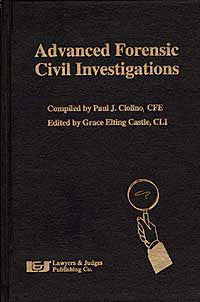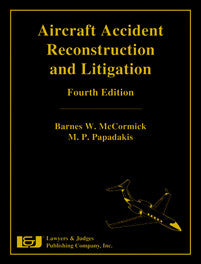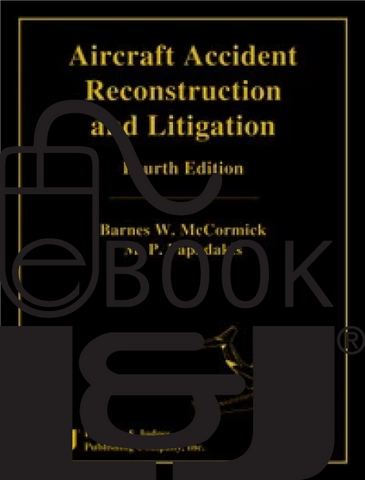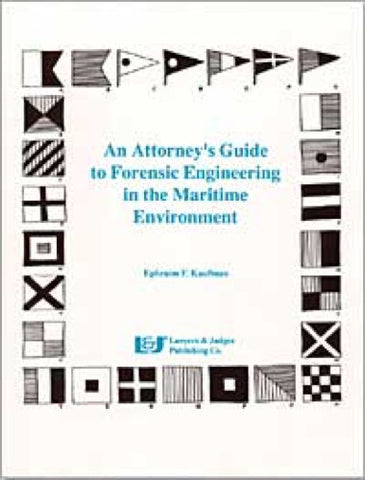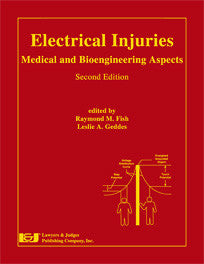
Electrical Injuries: Medical and Bioengineering Aspects, Second Edition
- Author: Raymond M. Fish, Leslie A. Geddes
- ISBN-10: 1-933264-63-2
- ISBN-13: 978-1-933264-63-9
- Copyright Date Ed: January 18, 2009
- Pages: 616
- Binding Information: Casebound
- Size: 8.5 ✕ 11 Inches (US)
Since the first edition of this book six years ago, new information about many aspects of electrical and blast injuries has become available. As a result, a variety of topics have been added and updated in this second edition. You will be pleased with the results. This book explains electrical and blast injuries in a useful way to physicians and other medical personnel, military personnel, patients and their families, educators, engineers, attorneys, and other professionals. Divided into six sections for ease of use and navigation, this book covers clinical management, bioengineering, body system injuries, electrical sources, accident reconstruction, and much more! Understanding electrical injuries and explosions (electrical or bombing-related) is complex and a multi-disciplinary perspective is required. Information from both medicine and engineering is relevant to the understanding of such injuries. This new edition offers you this approach.
This book is also available as an eBook. Click here to purchase and download:
Topics include:
- Basic concepts needed to understand electrical injury
- The let-go phenomenon
- Initial priorities: accident scene and emergency department
- Subtle diagnostic and prognostic factors in electrical trauma
- Treatment of specific injuries
- Patient disposition: indications for monitoring
- Electrical and terrorism-related explosions
- Sympathetically mediated pain
- Clinical approach to the electrocardiogram
- The physiology of cardiopulmonary resuscitation
- Electrical stimulation of the heart
Table of Contents
Chapter 1: Basic Concepts Needed to Understand Electrical Injury
1.1 Basic Electrical Terms
1.2 Basic Concepts Regarding the Flow of Electric Current
1.3 Capacitance
1.4 Primary versus Secondary Injury
1.5 Power
1.6 Voltages Involved in Electrical Injury
1.7 Skin Impedance
1.8 Stimulation of Excitable Cells
1.9 Simplified Resistance Model of the Human
1.10 Current Path
1.11 Amounts of Current Carried by Various Tissues
1.12 Injury without Burn Marks
1.13 Death Occurring without Skin Burns
1.14 Effects of Various Amounts of Current
1.15 Terminology: Static Stray, Fault, Step, and Touch Electricity
Chapter 2: The Let-Go Phenomenon
2.1 Types of Current Producing the Inability to Let Go
2.2 Pathophysiology
2.3 Why Inability to Let Go Results in More Severe Injury
2.4 Case Examples
Chapter 3:Initial Priorities: Accident Scene and Emergency Department
3.1 Accident Scene Care
3.2 The Accident Scene
3.3 Initial Emergency Department Approach to the Patient
Chapter 4: Subtle Diagnostic and Prognostic Factors in Electrical Trauma
4.1 History and Physical Examination Can Be Revealing
4.3 Predicting Future Effects of Electric Injury
4.4 Recognition of Occult or Developing Sequelae of Electrical Injury
4.5 Factors Suggesting Deep-Tissue Injury
4.6 Unusual, Delayed, and Apparently Exaggerated Signs and Symptoms Following Injury
Chapter 5: Treatment of Specific Injuries
5.1 Myoglobinuria
5.2 Gastrointestinal Injury
5.3 Vascular Insufficiency
5.4 Disseminated Intravascular Coagulation
5.5 Burns
5.6 Microwave Oven Injury
5.7 Progressive Tissue Necrosis Following High-Voltage Contact
Chapter 6: Treatment of Brain and Spinal Cord Injury
6.1 Brain Injury
6.2 Spinal Injury
Chapter 7: Patient Disposition: Indications for Monitoring
7.1 Recommendations for Monitoring
7.2 Studies Relevant to Cardiac Monitoring Recommendations
7.3 Discussion
7.4 Conclusion: Suggestions for Monitoring Patients
Chapter 8: Electrical and Terrorism-Related Explosions:Injury Characteristics
8.1 Sources of Blast Forces in Electrical Accidents
8.2 Terminology
8.3 Blast Injury
8.4 Cognitive Deficits Related to Blast Effects
8.5 Penetrating Injury
8.6 Toxic Chemicals in Explosions
8.7 Biological Materials in Explosions
8.8 Radioactive Materials In Explosions
Chapter 9: Electrical and Terrorism-Related Explosions:Diagnosis and Treatment
9.1 Initial Treatment Priorities
9.2 Specific Injuries
Chapter 10: Sympathetically Mediated Pain: RSD, CRPS, Causalgia, and Neuropathic Pain
10.1 Background Information
10.2 Diagnostic Criteria for Various Types of Sympathetically Mediated Pain
10.3 Types of Nerves Affected in Reflex Sympathetic Dystrophy
10.4 Skin Lesions in RSD
10.5 Delayed Onset of Reflex Sympathetic Dystrophy
10.6 RSD Following Electric Injury
10.7 RSD Following Lightning Injury
10.8 Causalgia due to Electric Current
10.9 Definitions of Some Signs and Symptoms
10.10 Abnormal Response to Cold in RSD
10.11 Edema (an Excessive Accumulation of Watery Fluid) Caused by Electrical Injury and RSD
10.12 Nerve Entrapment: A Sometimes Late Complication of RSD
10.13 CRPS, or Complex Regional Pain Syndrome
10.14 Treatment Sympathetically Medicated Pain, including RSD and Causalgia
Chapter 11: Clinical Approach to the Electrocardiogram
11.1 A General System for ECG Interpretation
11.2 Heart Rate
11.3 Rhythm Decoding
11.4 Effects of Electrolyte Imbalance
Chapter 12: The Physiology of Cardiopulmonary Resuscitation
12.1 Cardiac and Respiratory Arrest
12.2 Conventional CPR
12.3 Improved CPR
12.4 Modern Physiology of Blood Flow During CPR: Three Pump Mechanisms
12.5 Improved Methods of CPR Enhance the Operation of the Pumps
Chapter 13: Electrical Stimulation Basics
13.1 Strength-Duration Curves
13.2 Alternating-Current Stimulation
13.3 Electrode-Subject Impedance
13.4 Direct-Current Stimulation
13.5 Static Electricity Stimulation
13.6 Summary
Chapter 14: Stimulators: Historical and Technical Aspects
14.1 Stimulators Excite Nerve and Muscle
14.2 Early Experimental Stimulators
14.3 Stimulation Parameters
14.4 Basis for Stimulation
14.5 Galvanic-Faradic Stimuli to Diagnose NerveInjury
14.6 Modern Stimulators
Chapter 15: The Heart: Background Information with an Emphasis on Electrical Issues
15.1 Structure and Function of the Heart 1
15.2 Electrical Character of the Heart
15.3 The Electrocardiogram
15.4 Electrical Problems in the Heart
15.5 Electronic Monitoring during MyocardialInfarction
15.6 Cardiac Arrest
15.7 How Cardiac Arrest Is Treated
15.8 Consciousness during Cardiac Arrest
Chapter 16: Electrical Stimulation of the Heart-Introduction
16.1 The Natural Pacemaker and Signal Conduction System of the Heart
16.2 Fibrillation: Atrial and Ventricular
16.3 Defibrillation
16.4 Pacemakers for Bradycardia (Slow Heartbeat)
16.5 Failure to Detect Cardiac or Respiratory Arrest Because of Pacemaker Signals
16.6 MRI (Magnetic Resonance Imaging) for Patients with Pacemakers
16.7 The ICD (Implantable Cardioverter Defibrillator)
Chapter 17: Historical and Technical Highlights in Cardiac Pacing
17.1 Introduction to Historical Landmarks
17.2 The Earliest Cardiac Pacing
17.3 Human Transcutaneous Pacing
17.4 Clinically Useful Pacing
17.5 Transvenous Pacing
17.6 Closed-Chest Pacing
17.7 The Monopolar Catheter Electrode
17.8 The Implantable Pacemaker
17.9 Prolonging Battery Life
17.10 Unexpected Sudden Deaths
Chapter 18: Ventricular Fibrillation I: Basic Aspects
18.1 Cardiac Activity during Ventricular Fibrillation
18.2 The Vulnerable Period
18.3 Electrosurgical Current Produces Ventricular Fibrillation
Chapter 19: Ventricular Fibrillation II: Sudden Death from Electric Shock
19.1 Physiological Effects of Ventricular Fibrillation
19.2 Stimulation of Excitable Tissue
19.3 Electrophysiology of Ventricular Fibrillation
19.4 Summary
Chapter 20: Patient Monitoring and Measurements
20.1 The Electrocardiogram (ECG or EKG)
20.2 Circulation of the Blood
20.3 Central Venous Pressure (CVP)
20.4 Pulmonary Artery Capillary Wedge Pressure
20.5 Cardiac Output Measurements
20.6 Arterial Blood Gases
20.7 Blood Pressure
Chapter 21: Blood Pressure Measurement
21.1 The Concept of Counterpressure
21.2 Criteria for Systolic and Diastolic Pressure
21.3 The Modern Era
Chapter 22: Pulse Oximetry: Heritage of the Tissue-Bed Oximeter
22.1 The Importance of Pulse Oximetry
22.2 The First Oximeters
22.3 Historical Summary
Chapter 23: The Respiratory System
23.1 Respiratory System Structure and Function
23.2 Smoking
23.3 Control of Breathing
23.4 Arterial Blood Gases
23.5 Blood Gas Changes due to Respiratory Arrest
23.6 Oxygenation of Intubated Patients
23.7 Measuring Breathing: Spirometry
23.8 Respirators
Chapter 24: Burns I: Types of Electrical Contact and Related Burns
24.1 Electrothermal Burns
24.2 Arc Burns
24.3 Conduction by Streams of Liquid
24.4 Conduction through Shoes and Truck Tires
24.5 Electric Cord Injuries
24.6 Conduction by Moisture, Surface Contamination, Insulation Breakdown and Tiny Holes
24.7 Case Report: Holes in Rubber Overshoes, Loose, Jumping Power Line Contact
Chapter 25: Burns II: Characteristics of Skin Burns
25.1 General Appearance of Burns
25.2 Degrees of Burns
25.3 Gross and Microscopic Examination of Current Marks
25.4 Difficulty of Determining Extent of Deep Injury Related to Burns
25.5 Factors Related to the Formation of Burns
Chapter 26: Muscle and Skeletal Injury
26.1 Muscle Injury
26.2 Bone and Joint Injury
Chapter 27: Mechanical Brain Injury
27.1 The Physical Nature of Mechanical Head Injury
27.2 Sequelae of Head Injuries
27.3 Brain Imaging: CT, MRI, and SPECT
27.4 Case Examples
27.5 Conclusions
Chapter 28: Spinal Injury
28.1 Overview
28.2 MRI and Spinal Injury
28.3 Subacute Progressive Ascending Myelopathy
28.4 Defibrillations and Cardioversions
28.5 Cord Lesions from Hand-to-Hand Electric Contact
28.6 Vascular Injury Can Lead to Delayed Peripheral Nerve and Spinal Cord Dysfunction
28.7 Delayed Onset of Spinal Cord and Brain Dysfunction: Multiple Case Listing28.8 Case Reports
Chapter 29: Peripheral Nerve Injury
29.1 Mechanisms of Electric Injury to Peripheral Nerves
29.2 Pathophysiology of Delayed Nerve Injury
29.3 Specific Peripheral Nerve Injuries
29.4 Amount of Current Needed to Cause Injury
29.5 Case Examples of Delayed Peripheral Nerve Injury
Chapter 30: Auditory and Visual System Injury
30.1 Auditory System Injury
30.2 Visual System Injury
Chapter 31: Pulmonary, Cardiac, and Vascular Tissue Injury
31.1 Pulmonary Injury
31.2 Myocardial Injury
31.3 Vascular Injury
Chapter 32: Electroconvulsive Therapy (EST or ECT)
32.1 Types of Electric Current Used in Electroconvulsive Therapy
32.2 Complications
32.3 Making ECT Safer and More Effective
Chapter 33: Fetal Injury
33.1 Incidence of Fetal Death with Apparently Minor Maternal Electrical Injury
33.2 Fetal Movements: A Sign of Fetal Well-Being
3.3 Case Reports of Fetal Death
33.4 Case Reports of Fetal Injury with Survival
33.5 Treatment of Electrical Injury in Pregnancy
33.6 Information Relevant to Interpreting Case Report
Chapter 34: Psychological Effects of Electrical Accidents
34.1 Introduction
34.2 Neuropsychological Testing Is Often More Sensitive and Specific than Brain Imaging
34.3 Methodological Problems of Neuropsychological Studies Involving Electrical Accidents
34.4 Electric Current Flow through the Head
34.5 Impairment from Apparently Minor Blunt Head Trauma
34.6 Non-Contact Head Injury
34.7 How DSM Diagnostic Criteria are Organized
34.8 The Postconcussive Syndrome
34.9 Mild Traumatic Brain Injury
34.10 Medical Records Frequently Fail to Document Signs of Brain Dysfunction
34.11 Delayed Onset of Depression and Other Psychological Problems
34.12 Posttraumatic Amnesia and Prognosis
34.13 Recurrent Major Depressive Episodes
34.14 Posttraumatic Stress Disorder (PTSD)
34.15 Memory Dysfunction to Problems with Attention and Concentration
Chapter 35: Lightning Physics and Injuries
35.1 Lightning Facts
35.2 Incidence of Injury
35.3 Early Scientific Studies and Invention of the Lightning Rod
35.4 Physics of the Lightning Stroke
35.5 Basic Mechanisms in Lightning Injury
35.6 Pathophysiology of Lightning Injury (The Effect of Lightning on Tissue, Producing Pathological Changes)
35.7 Injuries from Lightning
35.8 Recognition and Treatment of Lightning Injuries
35.9 Prevention of Injury
35.10 Controversies in Lightning Injury
35.11 Conclusion
Chapter 36: Ball Lightning
36.1 Incidence
36.2 Properties Observed 3
6.3 Ball Lightning Associated with Man-Made Electric Power Sources 3
6.4 Experimentally Produced Ball Lightning
36.5 Types of Ball Lightning
36.6 Reported Injuries from Ball Lightning
36.7 Conclusions
Chapter 37: Electric Fences
37.1 Grounding
37.2 Sparks from Electric Fences
37.3 Fence Controllers with Continuous AC Output
37.4 Respiratory Arrest and Death from Continuous AC Fence Current
Chapter 38: Microwave Oven Injuries
38.1 Nerve Injury from Microwave Radiation
38.2 Steam Burns
38.3 Burns from Microwave Energy
38.4 Case Reports of Children Put in Microwave Ovens
38.5 Exploding Eggs and Eye Injury
38.6 Investigation and Treatment of Possible Microwave Burns
Chapter 39: Overhead Power Line Contact
39.1 Nature and Significance of the Problem
39.2 General Features of High-Voltage Burns: Results of a Representative Study
39.3 Fatality with Minimal Signs of Injury
39.4 Ground Faults
39.5 Case Examples
Chapter 40: Startle Reactions and Reflex Movements from Man-Made and Static Electricity
40.1 Startle Reactions and Reflex Movements Lead to Mechanical Trauma
40.2 Strong Muscle Contraction from Nerve or Muscle Stimulation
40.3 Reflex Reactions to Pain
40.4 The Trigemino-Cervical Reflex Protects the Face
40.5 Direct and Alternating Current
40.6 Startle Reactions
40.7 High-Voltage Power Sources
40.8 Static Electricity
40.9 Published Descriptions of Involuntary Reactions to Electric Current
40.10 Conclusions
Chapter 41: Electric Shock Drowning
41.1 A Tragic Story that Repeats
41.2 Voltage Gradients
41.3 Bonding Systems in Boats
41.4 Ground Faults
41.5 Swimming Pools
41.6 Body Resistance
41.7 Electric Shock Drowning Incidents in Marinas
Chapter 42: TASER(r) Electronic Control Devices
42.1 Some Basic Questions
42.2 Glossary of TASER-Related Terms
42.3 Cardiac Rhythm Glossary
42.4 Relevant Electrical Principles
42.5 How the ECD Indirectly Captures Muscles
42.6 Why TASER ECDs Do Not Cause Lethal Cardiac Rhythms
42.7 The TASER ECD Cannot Cause Cardiac Electroporation
42.8 The TASER ECD Cannot Cause Cardiac or Remote Burns
42.9 Lethal Fainting or Vasovagal Reaction
42.10 Emotional Stress as an Indirect Cause of Cardiac Arrest
42.11 No Increased Risk From Multiple Devices
42.12 Pacemakers and Implantable Defibrillators
42.13 The TASER ECD Does Not Harm Other Organs
42.14 Why Do Some People Die While Being Taken into Custody?
42.15 Anti-Police Organization Fund-Raising "Studies" are Junk Science
42.16 Epidemiology
Chapter 43: Forensic Perspectives in Electrical Fatality Cases: Guidelines for Investigators
43.1 Forensic Evidence
43.2 Forensic Investigation Guidelines: Electrocution Fatality Cases
Chapter 44: Accident Reconstruction in Electrical Injury Cases
44.1 Physiology and Accident Reconstruction
44.2 Tasks in Electrical Injury Accident Reconstruction
44.3 Case Examples
44.4 Conclusions
Chapter 45: Conscious Awareness During Fatal Electric Injury
45.1 Immediate Cardiac and Respiratory Effects of Various Amounts of Current
45.2 Mechanisms of Death
45.3 Cardiac Arrest
45.4 Consciousness and Awareness during Cardiac Arrest
45.5 Respiratory Arrest
45.6 Absence of Burns in Fatal Electric Injury
45.7 Conclusions
Chapter 46: Understanding the Information in Medical Records
46.1 The Importance of Medical Record Information
46.2 Difficulties in Obtaining Information
46.3 Information That Cannot Be Used
46.4 Sources of Information
46.5 History of an Accident
46.6 The Mechanism of Injury
46.7 Time Factors
46.8 Vital Signs
46.9 Preliminary Reports
46.10 Who Sees What
46.11 The Methodology of Medical Diagnosis
46.12 Misleading Test Results
46.13 Death Certificates and Autopsy Reports
46.14 Conclusion
Chapter 47: Researching the Medical Literature
47.1 PubMed Searches
47.2 Search Issues
47.3 Medical Literature Limitations
47.4 Conclusions
Chapter 48: Determining if an Electrical Accident is the Etiology of a Medical Condition
48.1 A Previous Evaluation Protocol
48.2 Modifying the Protocol
48.3 Determination of Medical Etiology
48.4 Epidemiological Studies Are Not Likely to Be Done
48.5 Autopsy-Related Considerations
Chapter 49: Illustrative Case Examples
49.1 Non-Accidental Electrical Injuries
49.2 The GFCI (Ground Fault Circuit Interrupter)
49.3 Touching of Plug Prongs, Moisture, Failure to Use GFCI and Delayed CPR Contribute to a Death
49.4 Talking after Fatal Electrocution, Current Path through Shoes, Straightening of Body with Hand-to-Foot Current Path, Ambulance Diverted from Hospital to Morgue
49.5 Need for GFCI Near Water

